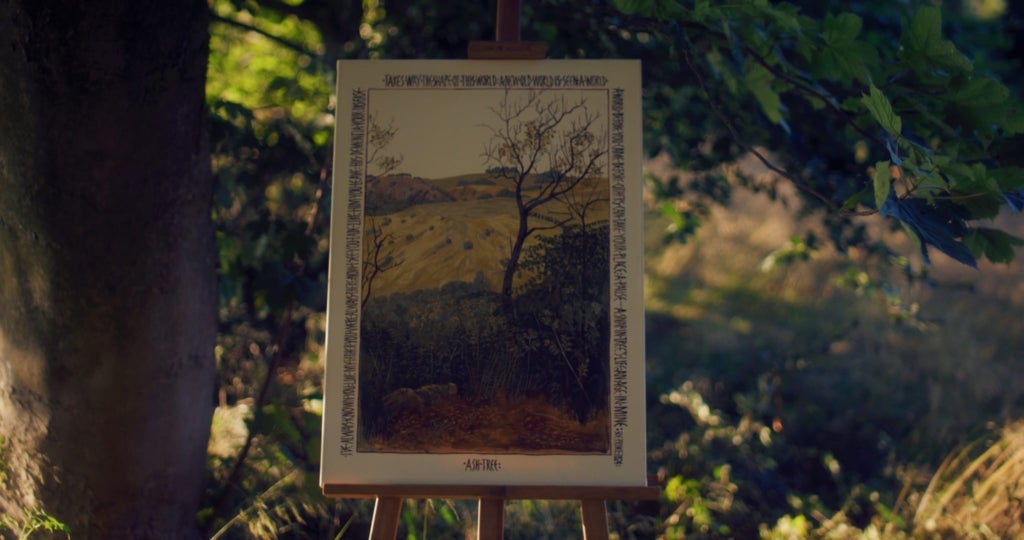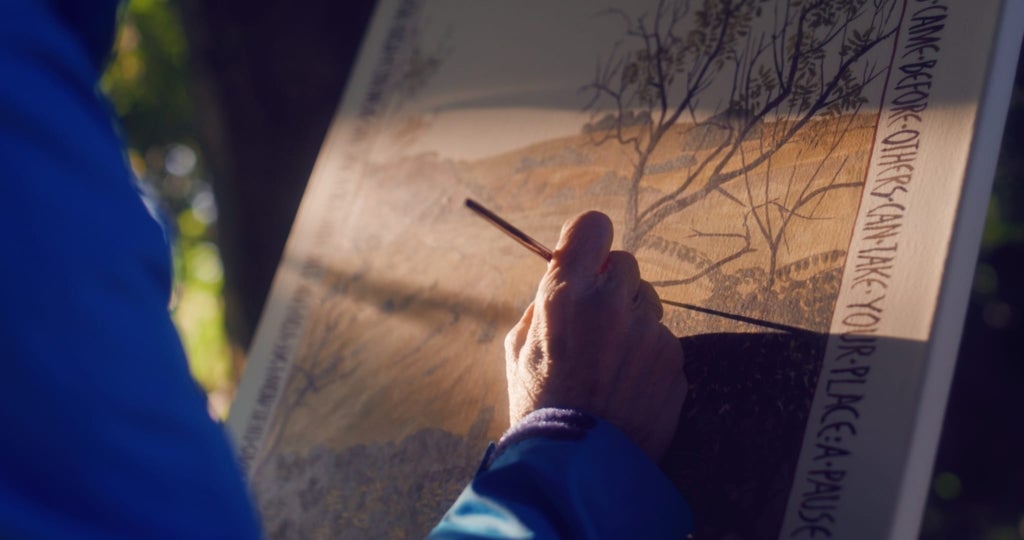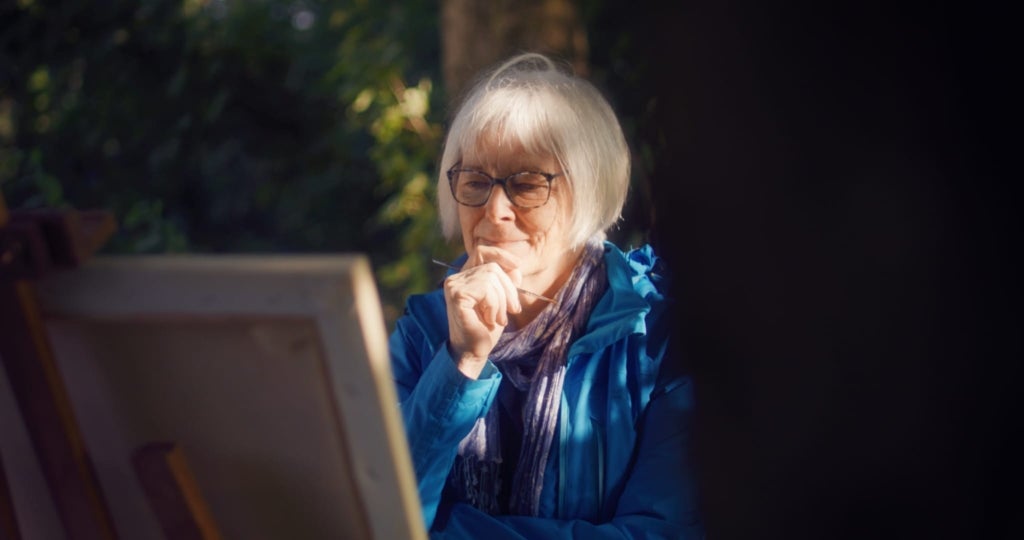Ash Dieback is a Dementia of the Landscape: A Painter Depicts a Story of Loss and the Impact of a European Union LIFE Project’s Restoration Work
News of the disease first reached painter Sue Prince and her husband on their organic dairy farm a few years ago. Prince had not noticed the subtle changes, the slow fading of life from the landscape, as a fungus took root in England’s Peak District. Once she did, she saw it everywhere. Ash dieback was affecting the young ash she had planted a decade ago, as well as mature trees nearby. The way their life was sapped from the inside out reminded her of another loss: the fading of her father as he progressed into dementia.

Ash dieback reached England’s Peak District in 2015. Due to human interference in the region, ash trees now dominate every level of the woodland ravine landscape. The foreign fungus Hymenoscyphus fraxineus—which causes ash dieback—spreads quickly via airborne spores that can travel for miles or to nearby trees through the movement of infected leaf litter. When it took hold in the species-homogenous ravine, it had no trouble migrating. In just five years, it had infected 99 percent of ash trees in the region.
The fungus attacks a tree’s vascular system, causing its leaves to wilt, spot, and die back. Prince described their emaciation, “more and more trees have the spindly branch ends, little ghost fingers reaching up as their life drains down.”
She began painting the trees to process her sadness. For her piece “Kintsugi Ash,” she drew on a Japanese art form used to repair broken pottery. Kintsugi uses gold to fuse shards back together into a usable whole that celebrates, rather than conceals, a piece’s imperfections. Prince used gold paint to portray an attempt at mending the tree’s stressed vascular system.
Most trees cannot be saved from dieback and eventually succumb to the disease.
Between Prince’s farm and the end of the road it sits on, there are about 50 Ash, 17 of them mature. She worries about their future. “I am heartbroken as I can see the character of our place change and become empty,” she said. She found herself counting the affected ash she passed on drives. “I couldn’t help seeing the farms, fields, and landscape without these trees,” she said. “It was so sad.”
She felt alone in her mourning. “My neighbors don’t talk about it,” she said. “Do they notice or feel the same? I don’t know. They worry about the cost of living and the day-to-day concerns.”
But others were thinking about the ash. In 2020, Natural England—an environmental advisor to England’s government—launched its LIFE in the Ravines project. The five year, £5-million, EU LIFE funded project aims to restore up to 25 percent of the ravine woodlands of the Peak District Dales, Special Area of Conservation.
The project recognizes that, though the disease takes root in ash, it impacts myriad woodland species. Insects, birds, and other creatures that rely on the ravines as habitat are all at risk. Natural England leads the project but partners with environmental organizations, including Derbyshire Wildlife Trust, Staffordshire Wildlife Trust, National Trust, and Chatsworth Estate, to plan and implement the work.
Together, they are tackling ash dieback with tree planting, seed collection, research, and sharing best practices from their work across almost 900 hectares (about 2,224 acres). They have conducted risk surveys to prioritize highly affected areas; helped maintain healthy, disease-free ash and removed some of their infected neighbors; planted a diverse array of native trees to improve the woodland’s future resilience; and leveraged technologies to aid in carrying out some of the most difficult plantings.
Eventually, this work will restore the diversity of tree species in the region to better resemble its state prior to significant human impact, making the landscape more resilient to future threats.
As the project neared completion, its leaders sought to communicate its story to the community. That is how they connected with Prince.
Prince is well established in the Peak District arts community. When Natural England began poking around for someone to help translate their scientific work into something emotionally resonant, her name came up repeatedly. “Her distinctive folk-art style, deeply rooted in the Peak District’s cultural heritage, captures both the ecological detail and emotional significance of our woodlands in a way that speaks to everyone who cherishes these landscapes,” said Katie Brownbill, communications and engagement officer for Natural England.

Natural England reached out to Prince about a collaboration, and she agreed. She had already explored the element of sadness around the trees’ loss. Now, she turned to the theme of their absence.
She thought, too, about the parallel with her father’s dementia. Walking through a once familiar landscape, and feeling a new barrenness was similar to being by her father’s side as he aged. “My father’s dementia took away much of his personality and his impact on his family. Gradually, he left before he finally died,” she said. In the UK, one in 11 people over age 65 have dementia, so the metaphor is powerful in helping others connect with her work and that of LIFE in the Ravines.
“His dementia showed in strange behaviors; the dying trees are strange in the woods—almost like living ghosts,” said Prince. “The dying ash trees take away characteristics of the personality of the Peak District—suddenly there are voids where there were shapes in the landscape like him losing stories, memories, and aspects of his place in the world.”
The painting she created shows the Peak District Dales landscape where a tree has been replaced through the LIFE in the Ravines project. It stands in the foreground, which is portrayed in muted colors. The landscape that stretches behind it is lighter and extends into a pale sky. The juxtaposition impresses the starkness of the current situation, while hinting at relief on the horizon.
The painting leaves a wide border of empty canvas, in which Prince inscribed a message:
“I’ve always known you. Like my father you were always there. Now I see you fade, like him you leave. His dementia your disease, takes away the shape of this world. A new, old world is seen. A world before you came before others can take your place. A pause…a snap in tree’s life, an age in mine.”
“This beautifully explains the emotional connection between her [Prince’s] personal loss, due to her father’s dementia, and the loss of our ash trees,” said Brownbill. “Their disappearance feels like losing an old friend, a silent witness to our personal histories.”
Much of the work of the LIFE in the Ravines project involved replanting. Prince said she has yet to address this chapter of the story, where a new landscape emerges. She hopes to, but not until the trees are more established. In the meantime, she is doing her own restoration work. Back on the farm, where her husband is now retired, the couple has planted 4,835 native trees of mixed species to create an open canopy woodland.
Prince knows that nature will persevere. When she looks back at photos of her community from over 100 years ago, there are no trees at all. “I know all will be well and nature will adapt eventually. It’s just that my time scale is so much shorter than nature’s,” she said.
The LIFE in the Ravines project is helping that adaptation. To date, it has planted over 70,000 trees across the region. It reached its goal of restoring 25 percent of most of its focus sites and has been granted a one-year extension to complete that work across its remaining locations in a final planting season. It will conclude in November 2026.
Prince is not sure what role her art will play in this conservation narrative, but others are. “Through her art, the complex story of ash dieback and our restoration work becomes accessible and moving,” said Brownbill. “Helping visitors, local communities, and conservation partners understand not just what we’re doing, but why it matters so deeply to us all.”
More about the Artist

Sue Prince is a UK-based folk artist. She lives on an organic dairy farm in England’s Peak District, where she uses art to tell the stories of the land, communities, and traditions that surround her. In 2004, she began working in an almost-extinct form of ancient Swedish egg tempera painting that combines image and calligraphy. She was instrumental in reviving the art form in Unnaryd, Sweden. She works on cotton canvas, real gesso, or acrylic gesso, with a limited palate of natural earth pigments and indigo. She grinds these pigments with water and using local eggs, striving to make her work as natural as possible. Her portfolio is available online at https://sueprinceartist.co.uk/.
More information about the LIFE in the Ravines project is available through its website http://www.lifeintheravines.co.uk/. It also shares updates and images of its work @LIFEinRavines on Instagram, X, and Facebook.
